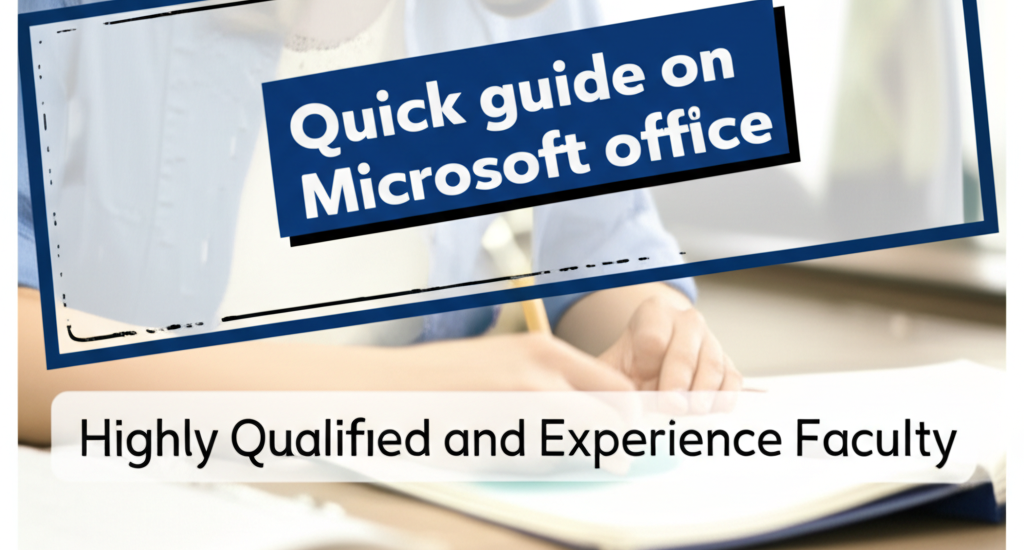Quick guide on Microsoft office
Introduction
You may feel a surge of anxiety when you’re choosing a Microsoft Office training class. Will you actually finish on time? Will the skills you gain translate to real-world tasks like drafting compelling documents, building powerful spreadsheets, or delivering impactful slide decks? The right program can transform your learning experience, speed your progress, and boost your confidence in Word, Excel, PowerPoint, Outlook, and more. This guide helps you navigate the selection process with clarity and purpose so you can make a choice that sets you up for success.
Tips to keep in mind as you compare options:
- Focus on outcomes you care about most (e.g., practical tasks, certifications, or portfolio-ready projects).
- Watch for up-to-date content that matches the latest Office version you’ll encounter in work or exams.
- Prioritize programs that offer hands-on practice and real-world assignments.
The 5-Point Evaluation Framework
To quickly compare options, center your decision on these five factors. Each one directly influences how much you learn, how quickly you progress, and how confident you’ll feel applying the skills later.
1) Faculty Credentials
- Qualifications that matter: look for instructors with Microsoft Office certifications (e.g., MOS, MCT) and real-world Office experience.
- Teaching proficiency: check for trained pedagogy, structured lesson plans, and evidence of student outcomes.
- Industry relevance: instructors who stay current with the latest Office features and workplace needs.
Why it matters: Strong credentials help you learn faster, understand practical workflows, and gain insights you can apply immediately in projects or assessments.
2) Quality of Study Material & Test Series
- Up-to-date materials aligned with the Office version you’ll use in real life or exams.
- Hands-on labs, templates, and real-world tasks that mirror typical office scenarios.
- Structured study plans and well-designed practice tests to track your progress.
- Accessible resources (online and offline) that you can revisit when needed.
Tip: Review a sample module and a demo test to gauge depth, clarity, and pacing before committing.
3) Batch Size & Peer Group
- Smaller batches tend to offer more personalized guidance and faster feedback.
- Peer learning accelerates comprehension through discussion, templates, and collaborative tasks.
- Check the typical batch size and how well the group supports your learning style.
Why it matters: A conducive peer environment plus accessible instructor support helps you stay motivated and accountable.
4) Historical Results & Student Testimonials
- Look for transparent metrics: pass rates, time-to-competency, or post-course outcomes.
- Read authentic testimonials or case studies that describe real skill application.
- Seek quantifiable improvements you can expect, such as faster document production or smarter data analysis.
Tip: If possible, reach out to former students or read independent reviews to validate claims.
5) Location & Feasibility
- Proximity and scheduling: consider commute time, session times, and flexibility (online, hybrid, or on-campus).
- Technology readiness: ensure you have the necessary tools and stable access to online platforms.
- Financial feasibility: compare pricing, hidden costs, and available payment plans or scholarships.
Why it matters: A program that fits your life reduces stress and allows you to stay consistent with practice and assignments.
The Non-Negotiable Step: Attend Multiple Demo Classes
Regardless of how convincing a brochure or testimonial sounds, you must experience live demos. Demo classes reveal the true dynamics of the program and help you answer questions you can’t answer from a catalog alone.
- Observe teaching style and pacing: does the instructor explain concepts clearly and wait for your questions?
- Assess engagement and accessibility: are activities hands-on, and are materials easy to follow?
- Evaluate content coverage: does the demo align with the outcomes you want (Word formatting, Excel data analysis, PowerPoint storytelling, etc.)?
- Ask practical questions: what happens after course completion (projects, certification prep, job-ready portfolios, or job assistance)?
- Check environment and support: is the learning environment supportive, and are there opportunities for feedback beyond class time?
Action steps you can take today:
- Sign up for at least two to three different demo classes across several providers.
- During each demo, note 5 key observations you care about most (e.g., clarity, pace, hands-on practice).
- Create a simple comparison sheet to record your impressions side by side.
Conclusion
To choose the right Microsoft Office training, focus on the five framework factors, verify the outcomes with historical results, and validate the experience through multiple demo classes. By following these steps, you position yourself to learn efficiently, apply skills confidently, and achieve your goals faster.
Start your personalized research journey today: compare programs, attend demos, and document what matters most to you. With intentional selection, you’ll turn your Office skills into tangible advantage—whether you’re drafting polished documents, analyzing data, or delivering compelling presentations.





